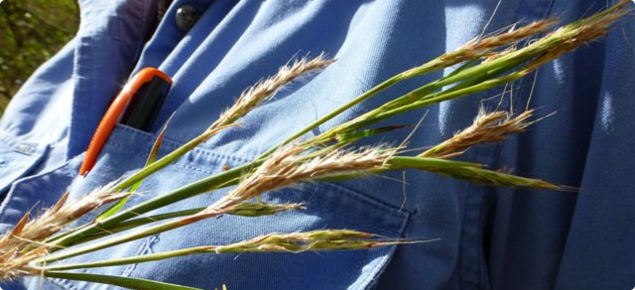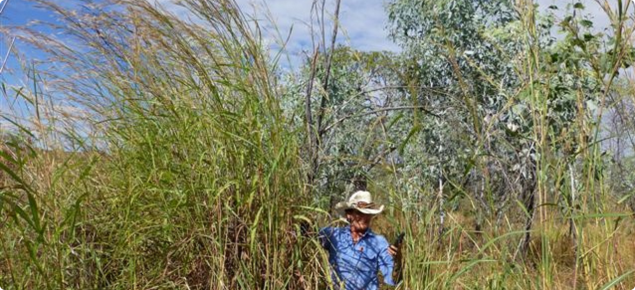Form: grass — perennial
Status: limited distribution in WA - targeted for eradication
A tropical invasive grass native to Africa. Gamba grass can reach 4-4.5 metres high and forms dense patches that could burn at high intensity; it out-competes native plants reducing natural biodiversity on non-grazed land. It grows in savannah woodlands where rainfall is over 600 millimetres per annum, in degraded areas, roadsides, and pastures as well as native vegetation.
Seeds spread by wind and water, and by vehicles and machinery in mud and on radiators.
A major weed of the Northern Territory (mainly around Darwin and Katherine) and also established on the Cape York Peninsula. It is regarded as a serious threat to savannas of northern Australia including the Kimberley. There is only one known infestation in WA - on a cattle station in the East Kimberley. It has been under an eradication program for a number of years to reduce spread and impact. It is also a weed in South America. Gamba grass is a Weed of National Significance (WoNS).
Appearance
Stems: Stems are robust and covered in soft hairs.
Leaves: Leaves to 30 centimetres long, to two centimetres wide and often with a white midrib.
Flowers: A typical grass seedhead, with terminal paired racemes that spread to a V-shape. Heads mature brown. Plant flowers in April.
Seeds: Seeds are contained in a fluffy V-shaped seed head consisting of up to six groups of branches, each containing 2–18 primary branches.
Agricultural and economic impact
Highly flammable, only palatable when young, grows to slightly more than three metres high.
Modelling indicates that gamba grass would cost Western Australia $110 million each year if it is not managed and $16.8 million if it is managed (Cook, D. 2014. Agricultural Resource Risk Management. Strategic Report: Impact Assessments for Declared Plants in Western Australia. July 2014. DAFWA. Western Australia).
Declared pest category
The Western Australian Organism List (WAOL) contains information on the area(s) in which this pest is declared and the control and keeping categories to which it has been assigned in Western Australia. Use the links on this page to reach gamba grass in WAOL.
Requirements for land owners/occupiers and other persons
Requirements for land owners/occupiers and other persons if this pest is found can be sourced through the declared plant requirements link.
Search > detect > report
| MyPestGuide™ Reporter | Pest and Disease Information Service (PaDIS) |
Control method
Before commencing control of gamba grass, report it to the Department of Primary Industries and Regional Development. Control methods for this declared plant can be found through the gamba grass control link.


